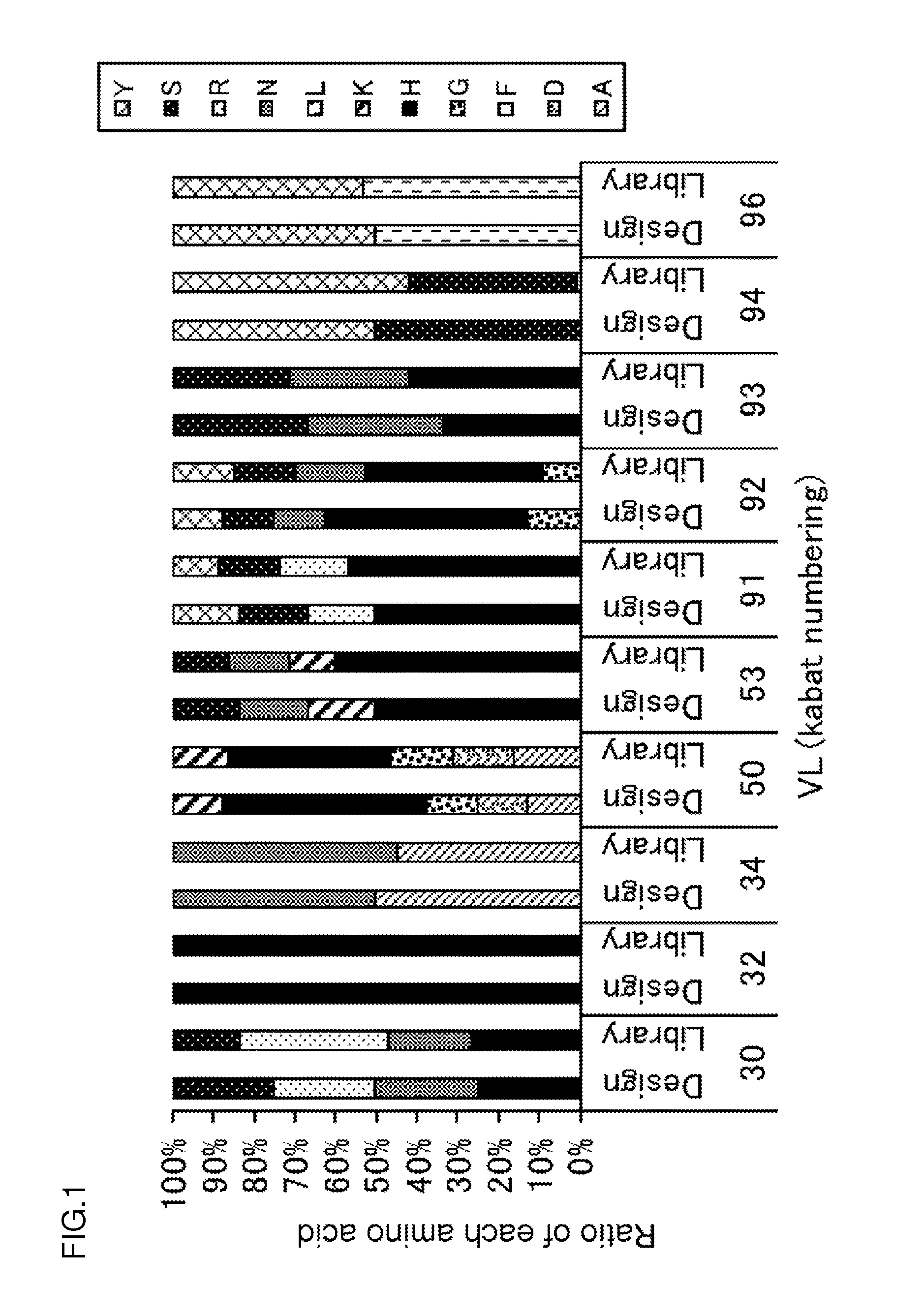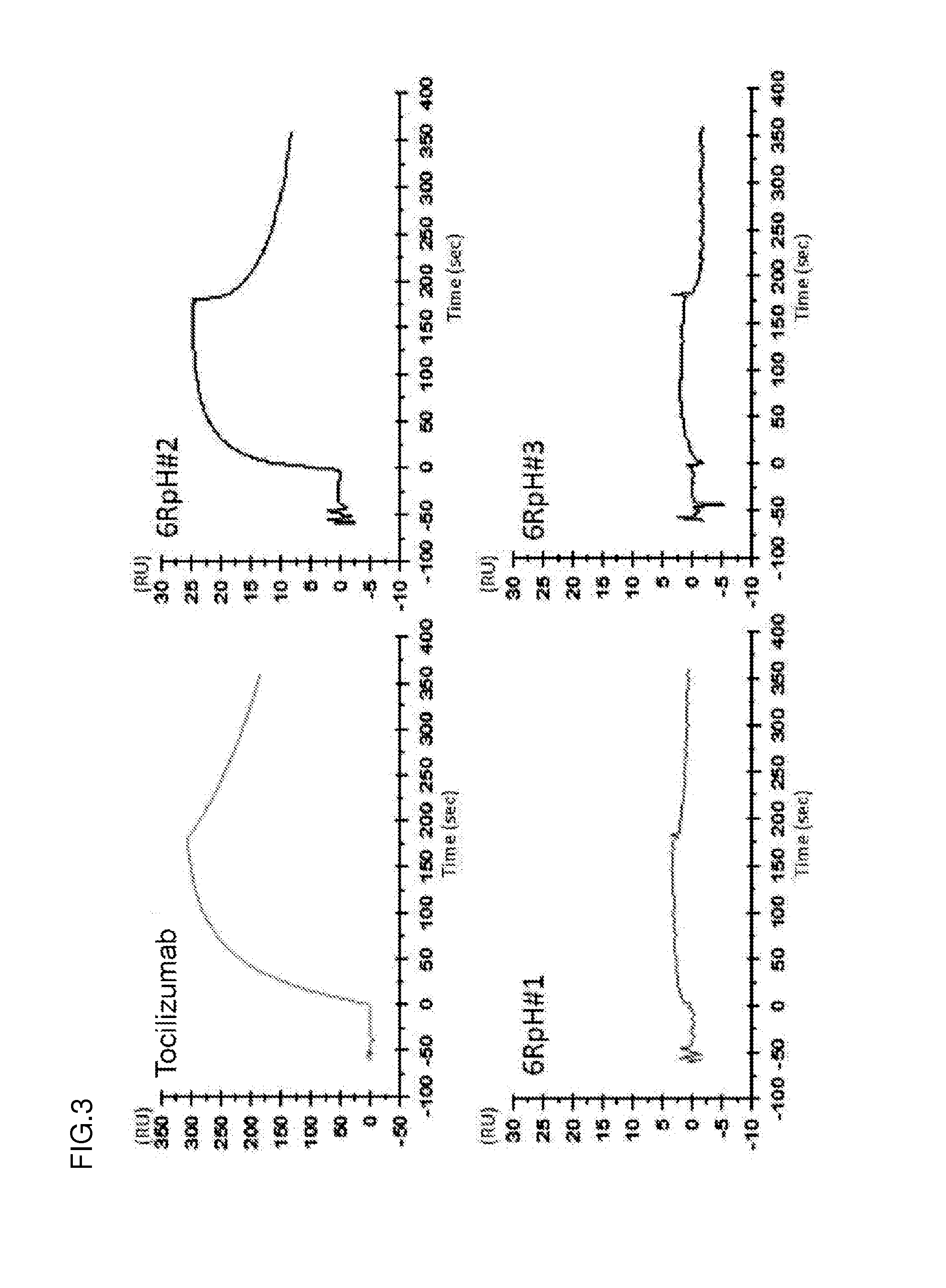Ion concentration-dependent binding molecule library
a technology of binding molecule and concentration, which is applied in the field of antigen-binding molecule library, can solve the problems of high production cost, difficult preparation of subcutaneous administration preparation, and stoichiometric limitation of neutralization reaction
- Summary
- Abstract
- Description
- Claims
- Application Information
AI Technical Summary
Benefits of technology
Problems solved by technology
Method used
Image
Examples
example 1
Design of pH-Dependent Binding Antibody Library
[0338](1-1) Method for Obtaining pH-Dependent Binding Antibody
[0339]WO2009125825 discloses that histidine is introduced to an antigen-binding molecule to prepare a pH-dependent antigen-binding antibody whose property is changed between neutral pH and acidic pH regions. The disclosed pH-dependent binding antibody is obtained by modification that substitutes a portion of the amino acid sequence of the desired antigen-binding molecule by histidine. A possible method for more efficiently obtaining the pH-dependent binding antibody without obtaining in advance the antigen-binding molecule to be modified involves introducing histidine to variable regions (more preferably, positions that may be involved in antigen binding) and obtaining an antigen-binding molecule binding to the desired antigen from the resulting pool of antigen-binding molecules (referred to as a His library). The antigen-binding molecule obtained from the His library has hig...
example 2
Preparation of Human Antibody Phage Display Library (His Library 1) for Obtaining Antibody Binding to antigen in pH-dependent manner
[0344]A gene library of antibody heavy chain variable regions was amplified by PCR using poly-A RNA prepared from human PBMC, commercially available human poly-A RNA, or the like as a template. A gene library of antibody light chain variable regions designed as the His library 1 described in Example 1 was amplified using PCR. Combinations of the sequences in the gene library of antibody heavy chain variable regions and the gene library of antibody light chain variable regions thus prepared were inserted into phagemid vectors to construct a human antibody phage display library displaying Fab domains composed of human antibody sequences. The construction method was performed with reference to Methods Mol. Biol. (2002) 178, 87-100. In this construction of the library, the sequence of a phage display library was used, which comprised a linker portion for li...
example 3
Obtainment of Antibody Binding to IL-6R in pH-Dependent Manner
[0345](3-1) Obtainment of Antibody Fragment Binding to Antigen in pH-Dependent Manner from Library by Bead Panning
[0346]The first round of screening of the constructed His library 1 was carried out by the enrichment of only antibody fragments having antigen (IL-6R)-binding ability.
[0347]Phages were produced from E. coli carrying the constructed phagemid for phage display. 2.5 M NaCl / 10% PEG was added to cultures of E. coli that had produced phages, and a pool of the phages thus precipitated was diluted with TBS to obtain a phage library solution. BSA and CaCl2 (final concentration: 4% BSA and 1.2 mM calcium ion) were added to the phage library solution. The panning method was performed with reference to a general panning method using antigens immobilized on magnetic beads (J. Immunol. Methods. (2008) 332 (1-2), 2-9; J. Immunol. Methods. (2001) 247 (1-2), 191-203; Biotechnol. Prog. (2002) 18 (2) 212-20; and Mol. Cell Prote...
PUM
| Property | Measurement | Unit |
|---|---|---|
| Time | aaaaa | aaaaa |
| Time | aaaaa | aaaaa |
| Molar density | aaaaa | aaaaa |
Abstract
Description
Claims
Application Information
 Login to View More
Login to View More - R&D
- Intellectual Property
- Life Sciences
- Materials
- Tech Scout
- Unparalleled Data Quality
- Higher Quality Content
- 60% Fewer Hallucinations
Browse by: Latest US Patents, China's latest patents, Technical Efficacy Thesaurus, Application Domain, Technology Topic, Popular Technical Reports.
© 2025 PatSnap. All rights reserved.Legal|Privacy policy|Modern Slavery Act Transparency Statement|Sitemap|About US| Contact US: help@patsnap.com



